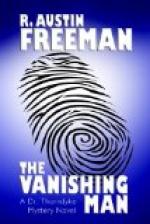“I am rather surprised,” said he, “that you chose so composite an object as a mummy to begin on. I should have thought that a simpler object, such as a coffin or a wooden figure, would have been more instructive.”
“In some ways it would,” replied Thorndyke, “but the variety of materials that the mummy gives us has its advantages. I hope your father is not ill, Miss Bellingham.”
“He is not at all well,” said Ruth, “and we agreed that it was better for me to come alone. I knew Herr Lederbogen quite well. He stayed with us for a time when he was in England.”
“I trust,” said Dr. Norbury, “that I have not troubled you for nothing. Herr Lederbogen speaks of ’our erratic English friend with the long name that I can never remember,’ and it seemed to me that he might be referring to your uncle.”
“I should hardly have called my uncle erratic,” said Ruth.
“No, no. Certainly not,” Dr. Norbury agreed hastily. “However, you shall see the letter presently and judge for yourself. We mustn’t introduce irrelevant topics while the experiment is in progress, must we, Doctor?”
“You had better wait until we have finished,” said Thorndyke, “because I am going to turn out the light. Switch off the current, Polton.”
The green light vanished from the bulb, the hum of the interrupter swept down an octave or two and died away. Then Thorndyke and Dr. Norbury rose from their chairs and went towards the mummy, which they lifted tenderly while Polton drew from beneath it what presently turned out to be a huge black-paper envelope. The single glow-lamp was switched off, leaving the room in total darkness, until there burst out suddenly a bright orange-red light immediately above one of the trays.
We all gathered round to watch, as Polton—the high-priest of these mysteries—drew from the black envelope a colossal sheet of bromide paper, laid it carefully in the tray and proceeded to wet it with a large brush which he had dipped in a pail of water.
“I thought you always used plates for this kind of work,” said Dr. Norbury.
“We do, by preference; but a six-foot plate would be impossible, so I had a special paper made to the size.”
There is something singularly fascinating in the appearance of a developing photograph; in the gradual, mysterious emergence of the picture from the blank, white surface of plate or paper. But a skiagraph, or X-ray photograph, has a fascination all its own. Unlike an ordinary photograph, which yields a picture of things already seen, it gives a presentment of objects hitherto invisible; and hence, when Polton poured the developer on the already wet paper, we all craned over the tray with the keenest curiosity.




